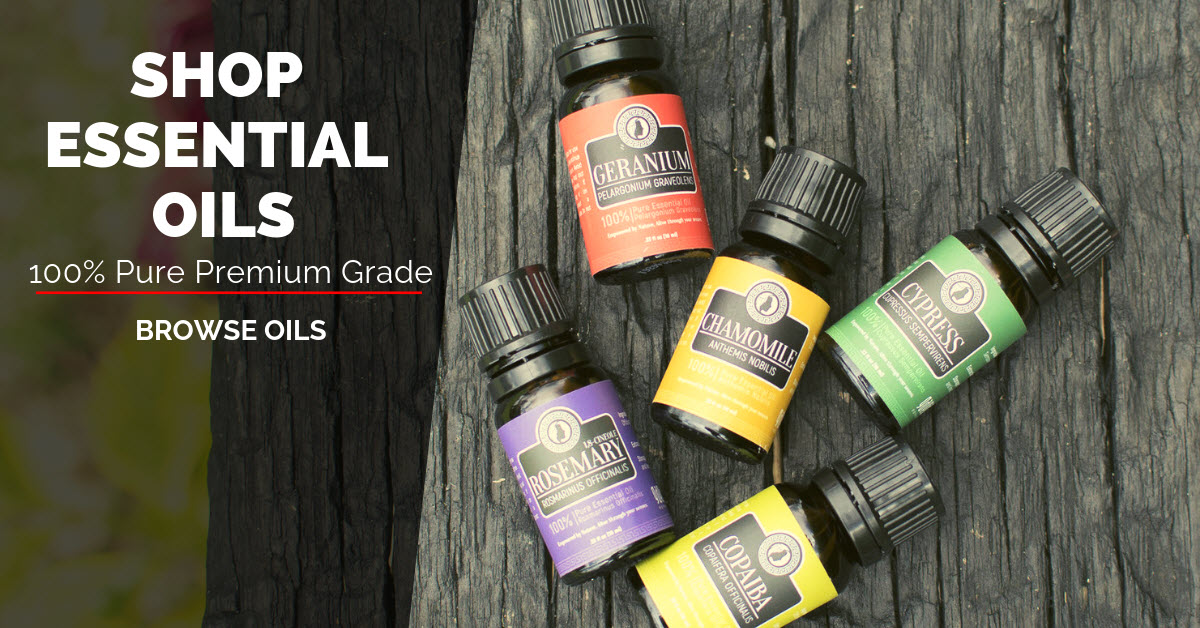Imagine getting a pedicure and then a few weeks later when you remove the polish, you notice a little yellow spot under your nail. You don’t think much of it, but it grows and soon your nail starts cracking.
Or perhaps you have been hiking or backpacking a lot. Your feet have been sweaty, and you haven’t been changing out your socks frequently. The warm, dark, moist environment inside your boots is the perfect breeding ground for something quite nasty – toenail fungus.
None of us want to contract this unpleasant and unsightly condition. Thankfully if we do find ourselves in the position of having to deal with a fungal infection, essential oils are there to help us.
Why Essential Oils Are Good For Toenail Fungus
Fungal infections of the toenails are caused by dermatophytes. Dermatophytes are the specific varieties of fungi – trichophyton rubrum and trichophyton mentagrophytes – that infect skin and nails.
Standard treatments for toenail fungi consist of oral and topical antifungal medications. These can cause side effects and may not even be effective since there are more and more strains of medication resistant fungi cropping up.
It makes sense that plants, particularly those that grow in conditions where fungi are often present, would develop an innate resilience towards infection. When scientists tested that hypothesis in laboratory settings, they indeed found that many essential oils possess antifungal properties that we can benefit from.
Here are 8 of the best essential oils to use when dealing with toenail fungus:
Best Essential Oils For Toenail Fungus
1. Cinnamon Leaf (Cinnamomum verum)
We may enjoy the sweet spiciness of cinnamon, but thankfully our toenail fungus does not. Cinnamon leaf thwarts the evils of toenail fungus with help from its main component – cinnamaldehyde.
Cinnamaldehyde’s superpower is a demonstrated ability to break down existing fungi and also inhibit the growth of new fungi. Scientists say it works against the fungus Trichophyton rubrum which causes the majority of toenail fungal infections.
Dilute 3 drops of cinnamon leaf in 1 ounce of fractionated coconut carrier oil and use a cotton swab to apply directly to affected nail(s) daily until fungus disappears.
Note: Maximum topical dilution of 0.6%
2. Clove Bud (Syzygium aromanticum)
Clove bud is another delightfully potent and multi-versatile spice. We are familiar with clove bud’s exotic warmth in the kitchen, but did you know that clove bud’s oil also has some impressive antifungal properties?
Clove bud’s defensive weapon of choice is eugenol. This compound defends the clove plant (and by extension you, when you use the oil) against the most common strains of not only fungal but also yeast infections.
Upgrade your usual foot powder by adding 6 drops of clove bud per tablespoon of powder. Bonus points for making your own natural moisture absorbing powder with arrowroot flour.
3. Eucalyptus (Eucalyptus odorata)
Eucalyptus’ strong menthol aroma hints to its capabilities as a very effective antifungal agent. We have all heard of eucalyptus, but who knew that there are many different species and that those species can have very different capabilities?
This makes sense when we realize that each species is different in part because of the variations in their chemical composition. Which species work best on toenail fungus? Scientists were wondering that as well, so they tested it out.
Be sure to check your species when purchasing because while all species of eucalyptus showed antifungal properties, Eucalyptus odorata achieved an amazing 100% effective elimination of the three most common forms of nail fungus.
Help ward off potential infections by adding 12 drops of eucalyptus to 2 tablespoons of your daily foot lotion. Be sure to massage it into the cuticles and nails.
Note: Not suitable for use on children’s faces
4. Manuka (Leptospermum scoparium)
Manuka is an exotic oil renowned for its whole-body healing powers especially in the form of manuka honey. Now manuka oil is becoming more well-known for its antifungal abilities. The manuka plant has to protect itself from environmental hazards in its native Australian environment. This imbues it with antifungal properties that can benefit us.
Dilute 12 drops of manuka oil in a half ounce of carrier oil like jojoba and a tablespoon of dispersant like whole milk. Add to a foot bath. Soak your feet for at least 20 minutes so that the oil can absorb into your skin.
5. Oregano (Origanum vulgare)
Kitchen herbs are such amazing plants! Not only do they bring life to our dishes, but many of them also possess chemical properties that make them apt at improving our quality of life. Case in point: oregano.
Oregano is an antifungal rockstar. When analyzed in a lab setting, oregano was found to be one of the most effective of a whopping 20 essential oils when it came to helping resolve nail fungus infections.
Dilute 6 drops of oregano in a half ounce of jojoba oil. Use a cotton swab to apply directly to affected nail(s) daily until fungus disappears.
Note: Inhibits blood clotting (use caution if taking anticoagulant medication, if you have a bleeding disorder, or are going to have major surgery). Maximum topical dilution 1.1%.
6. Palmarosa (Cymbopogon martinii)
With antifungal medications becoming increasingly less effective, science is turning back to nature for solutions. One of the oils that keeps rising to the top in these studies is palmarosa. Palmarosa oil is steam distilled from the tropical palmarosa grass which is native to India.
Not only does this wonder oil help us combat a wide variety of the most common fungi, but lab tests also found that it was outstanding with resolving bacteria and yeast infections as well.
Make your own nail and cuticle health oil by adding 9 drops of palmarosa to 3 teaspoons of carrier oil like jojoba or fractionated coconut. Use daily to keep nails moisturized and discourage bacterial and fungal growth.
7. Tea Tree (Melaleuca alternifolia)
No list of antifungal essential oils would be complete without the star of the show: tea tree. This ubiquitous oil is well known and well-loved with great reason. In the case of toenail fungus, it’s official: scientific studies have specifically tested and confirmed that tea tree helps to inhibit the growth of many fungi including Trichophyton rubrum which is responsible for most cases of toenail fungus.
For active fungal infections, use a cotton swab to apply a dilution of tea tree directly to affected nail(s) daily until fungus fully disappears. Craft your own blend with 15 drops of tea tree in half an ounce of fractionated coconut oil.
Note: Maximum topical dilution of 15%
8. Thyme (Thymus vulgaris)
Thyme lights up our taste buds and cleans up our feet. This humble herb is there to defy drug-resistant strains of fungus which have necessitated the use of alternative treatments to replace traditional prescription antifungals. The thymol concentration in thyme works well alone and can also be paired with a standard fluconazole antifungal medication for really pesky but not drug resistant infections.
Help protect your feet while hiking. Make a mini fungus defying spray to mist on the inside of your socks between uses. Combine 2 ounces of water with 1 tablespoon of liquid castile soap and 5 drops of thyme. After spraying the socks, let them dry inside out in the sun for extra sanitation.
Note: Avoid use on young children. May inhibit blood clotting. Maximum topical dilution of 1.3%
Best Essential Oil For Toenail Fungus Recipes
Essential Oils Fungus Fighter Footbath
Fill a foot bath or basin with nice warm water. To this water add a blend of:
- 6 drops oregano
- 6 drops thyme
- 1 ounce unscented liquid castile soap (or whole milk if you prefer)
Soak feet in bath for 20-30 minutes. Pat dry. Topical Essential Oils Nail Fungus Crusher
In a dark colored glass jar, combine:
- 3 drops cinnamon
- 14 drops clove
- 13 drops tea tree
- 1-ounce fractionated coconut carrier oil
Apply blend directly to affected nail one to two times a day until infection appears to be completely gone.
Continue applying blend once daily for another 2-4 weeks to ensure no lingering fungus remains.
Happy Fungus-Free Essential Oils Foot Lotion
In a double boiler (or a glass jar standing in a pan of water) combine:
- ¼ cup shea butter
- ¼ cup coconut carrier oil
- 1/8 cup jojoba carrier oil
- 3 tablespoons beeswax
Heat slowly, stirring constantly until melted.
Remove from heat and allow to cool until mixture just begins to thicken.
Add:
- 12 drops eucalyptus
- 18 drops manuka
- 18 drops palmarosa
Whip mixture in a blender if you prefer a light, body butter texture. For a thicker salve type feel, simply stir in the essential oils and allow mixture to fully set.
Massage into feet and nails daily to help prevent fungus friendly cracks from forming.
You can also protect your feet by thoroughly washing your socks. Kill any fungus spores that may be lurking by adding a blend of ½ cup of Epsom salts and 24 drops of tea tree oil to the final rinse water.
To Summarize
- Toenail fungus is an infection of the toenails are caused by dermatophytes. Dermatophytes are the specific varieties of fungi – trichophyton rubrum and trichophyton mentagrophytes – that infect skin and nails.
- Essential oils are good for toenail fungus because they have antifungal properties and are effective on even drug-resistant strains of fungi.
- The best essential oils for toenail fungus include: cinnamon leaf, clove bud, eucalyptus, manuka, oregano, palmarosa, tea tree, thyme.
Read more:



I like the helpful info you supply for your articles. Keep up the great work!
Thanks so much for the lovely feedback!